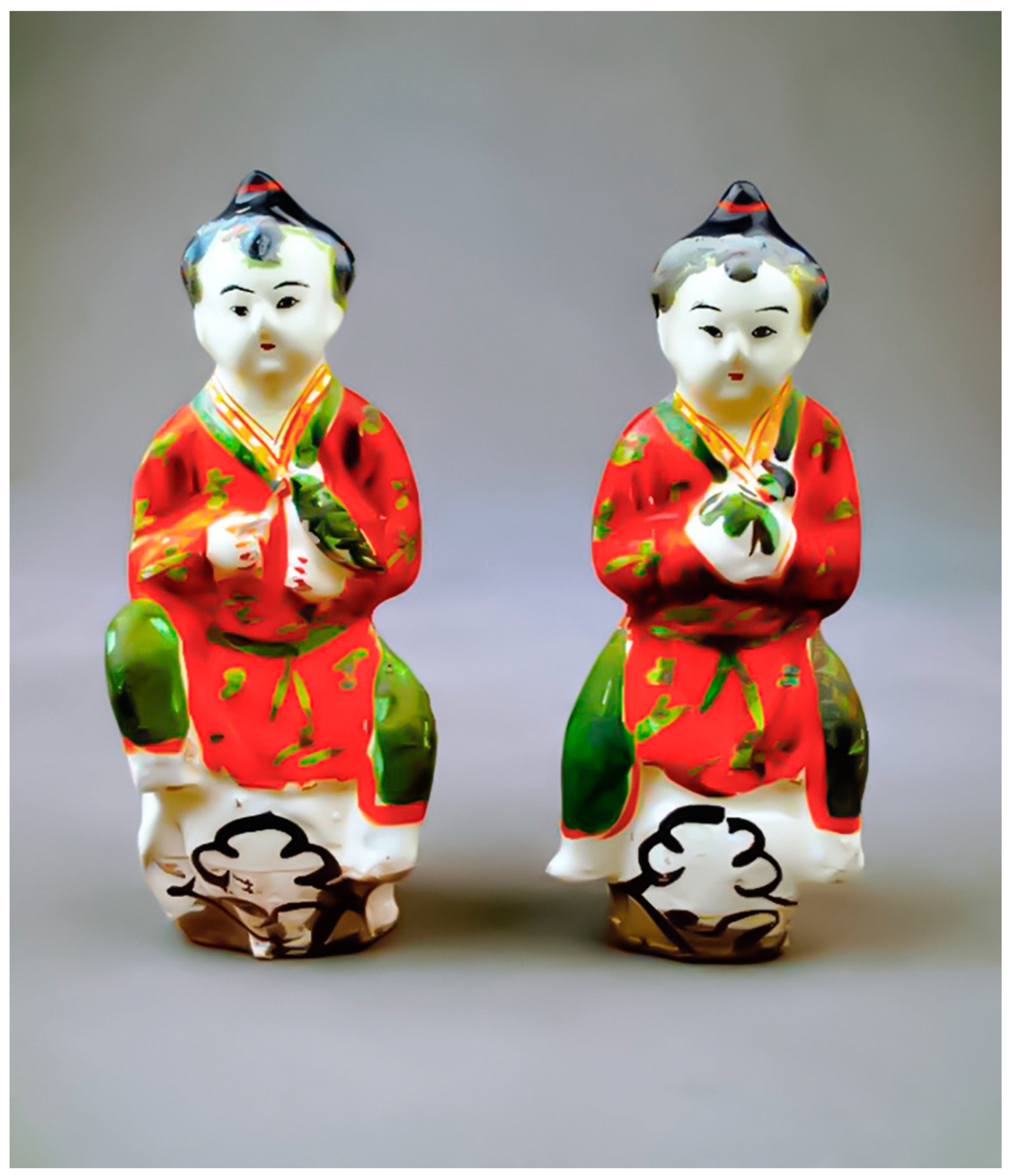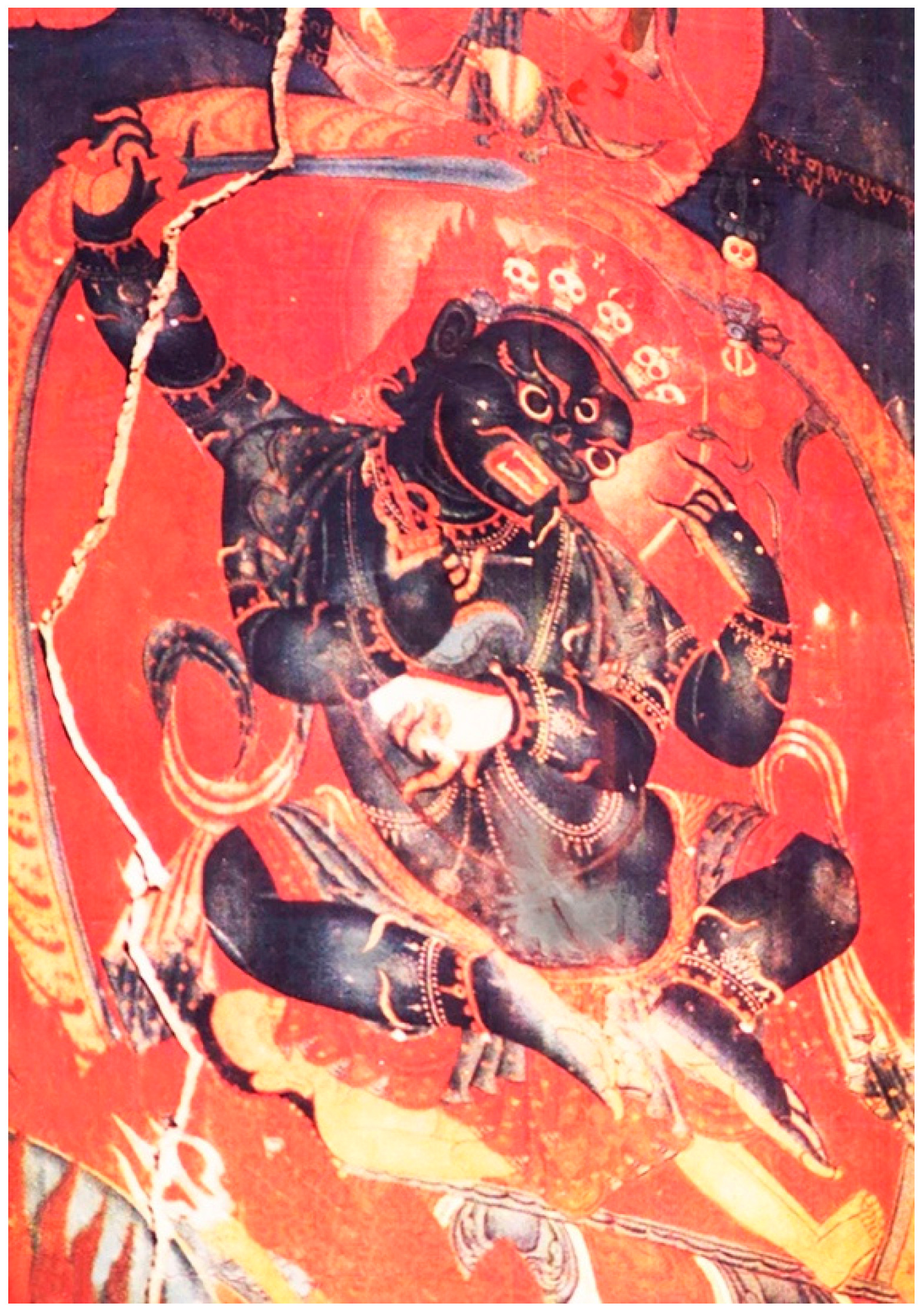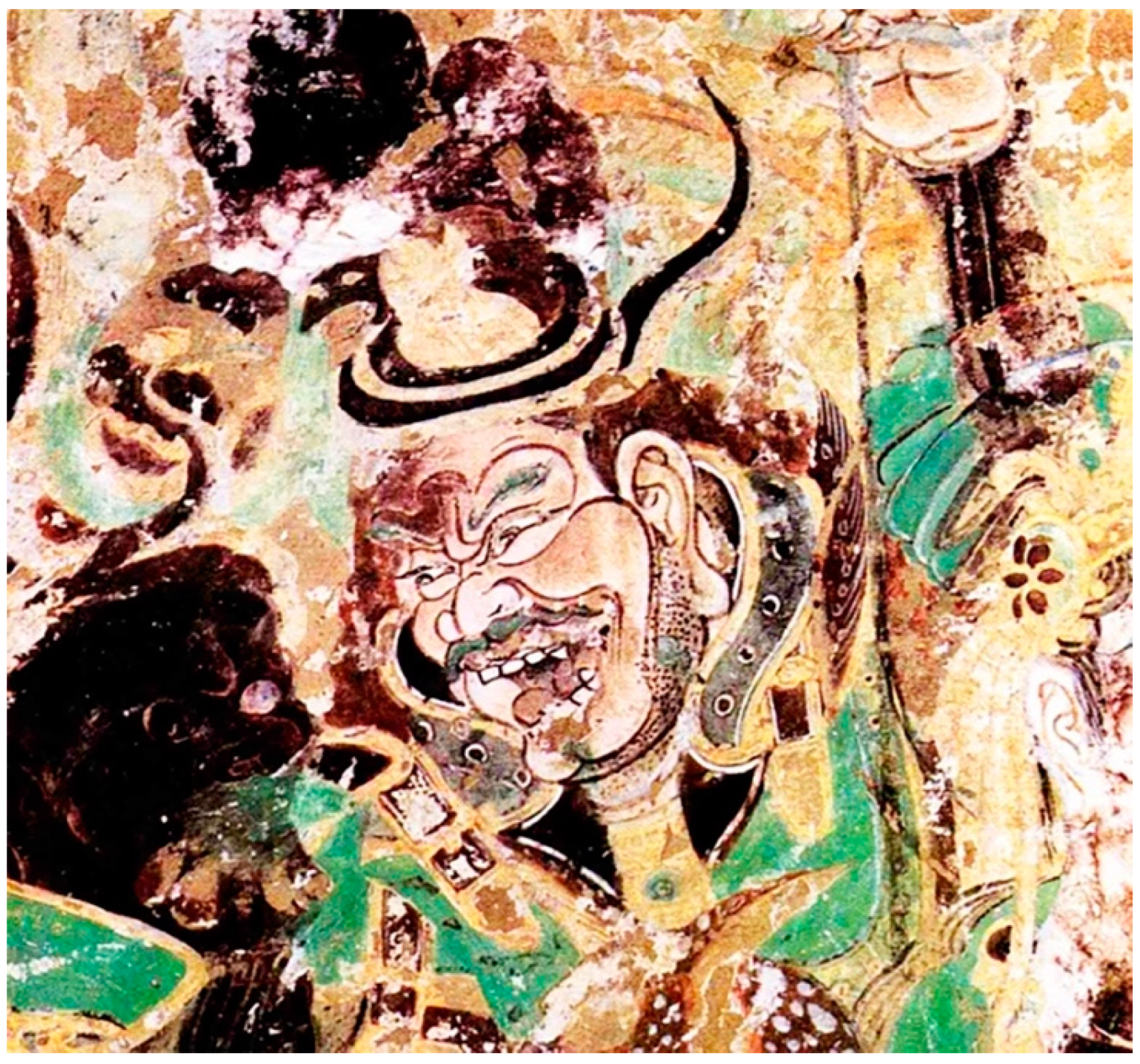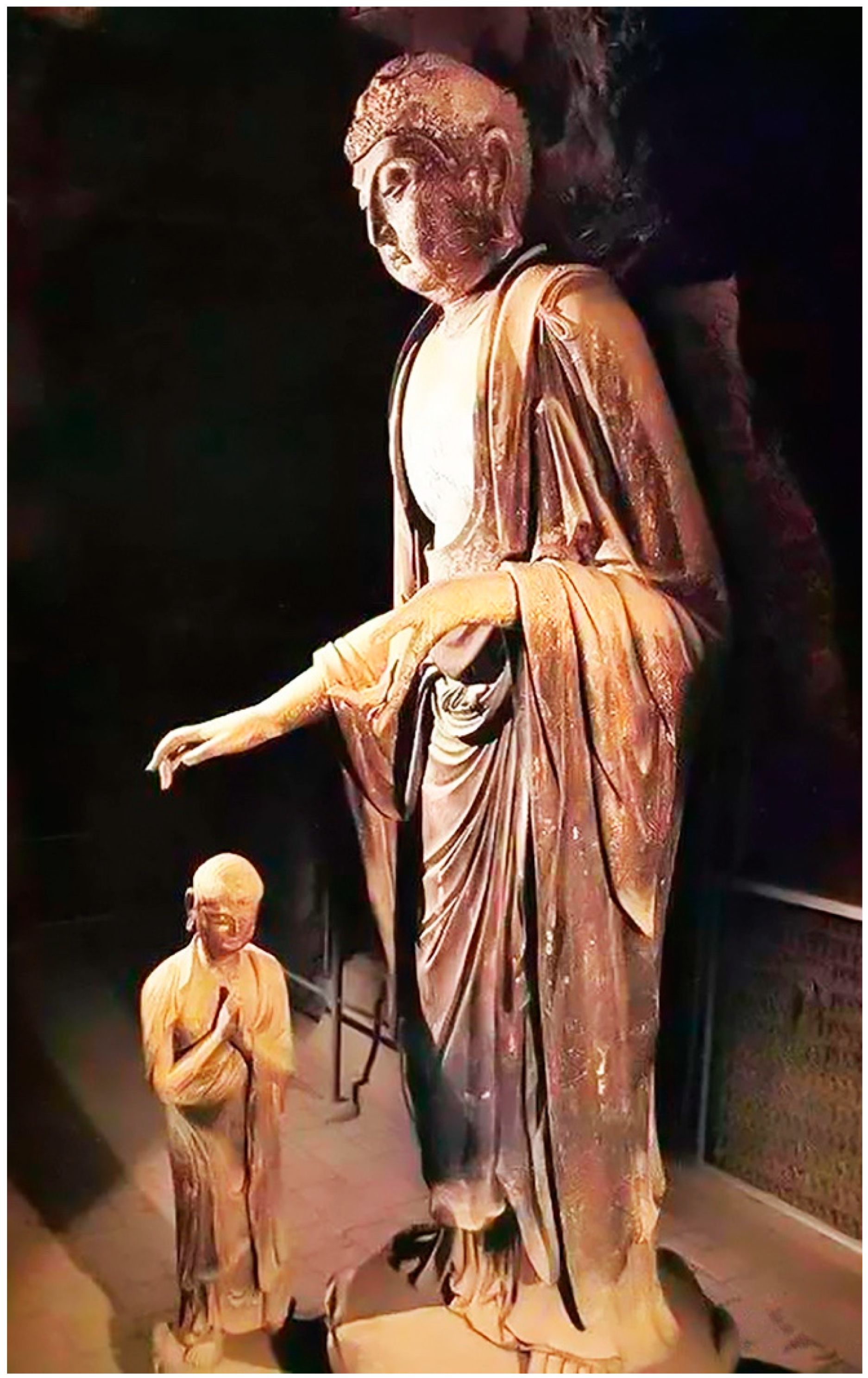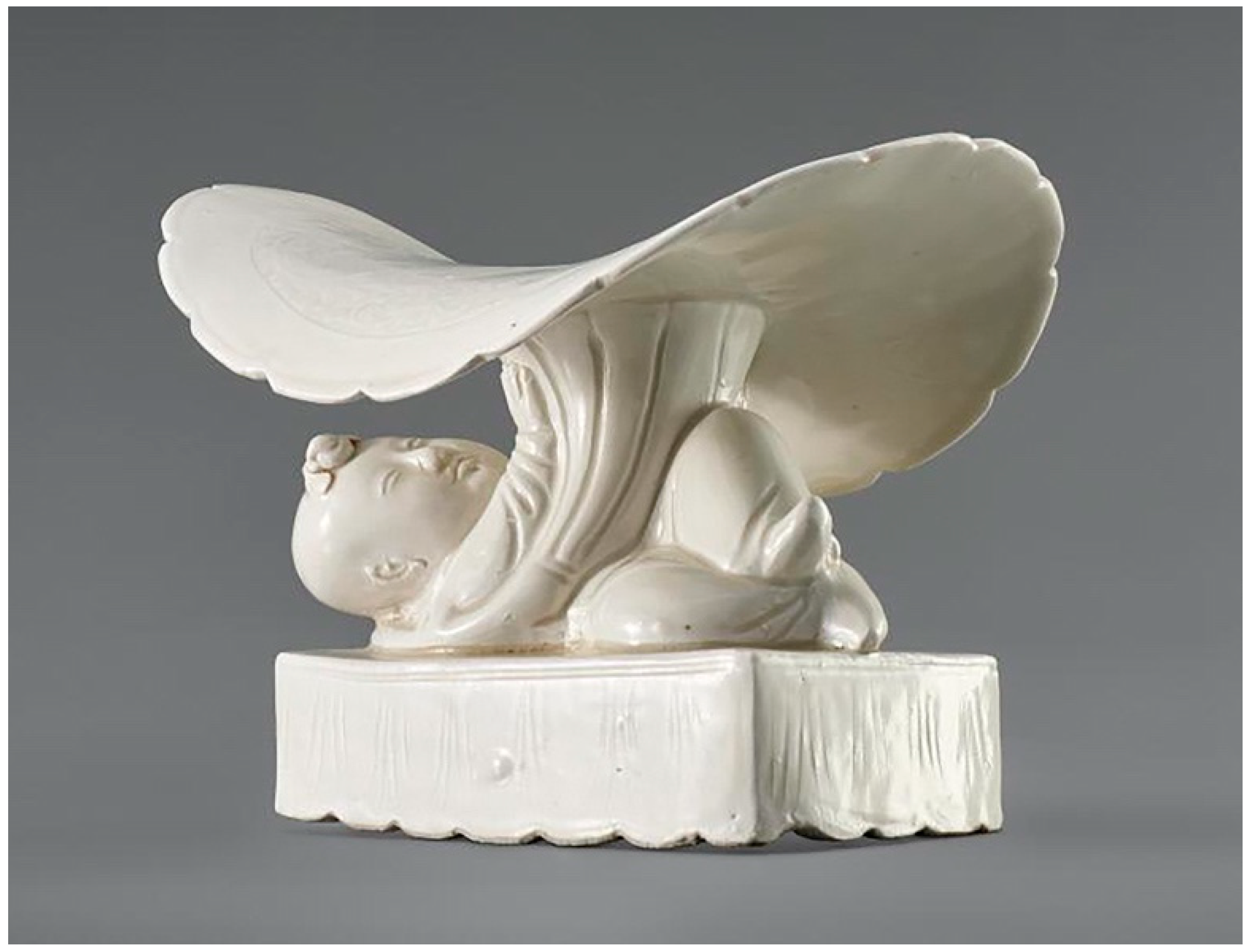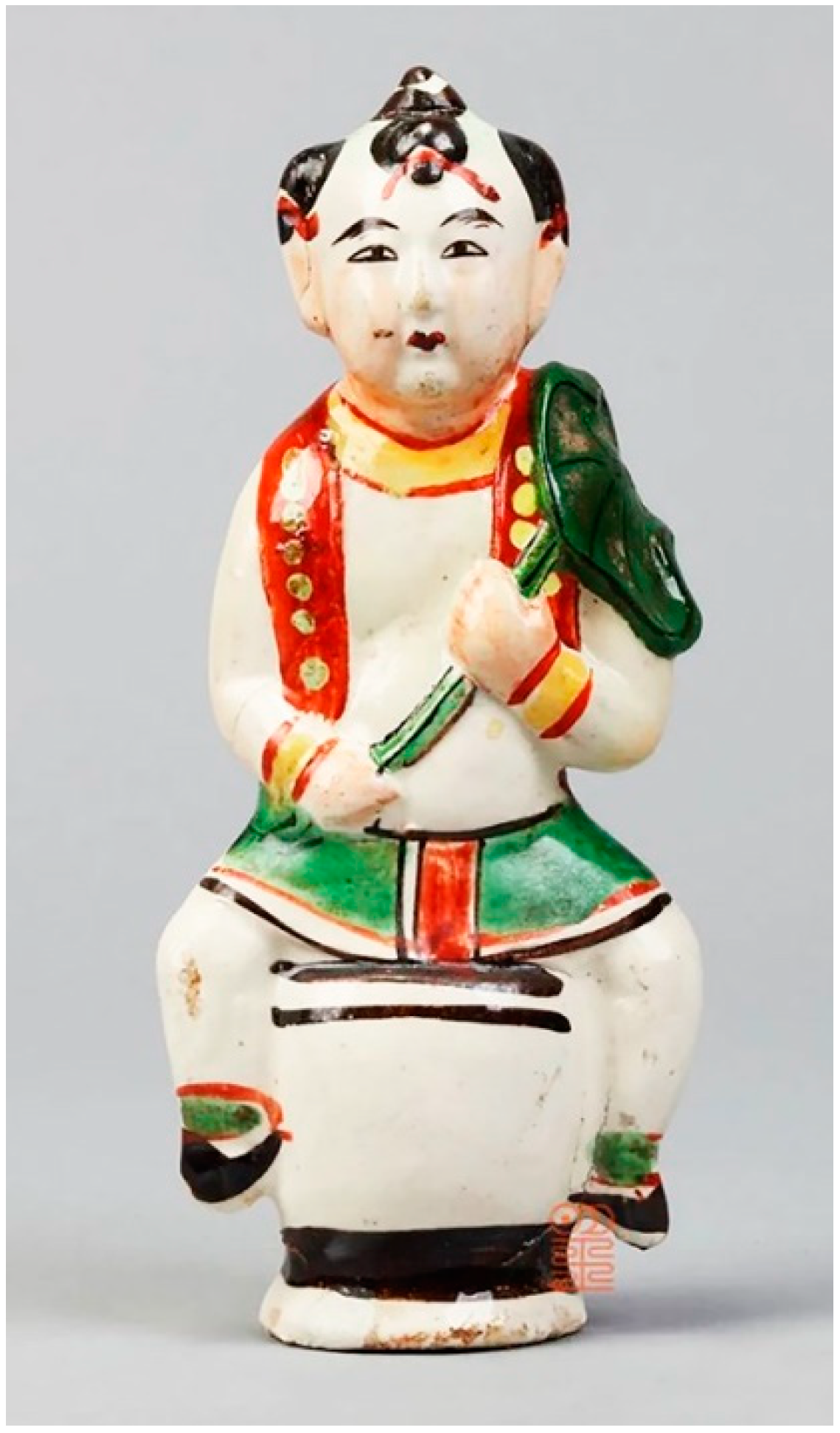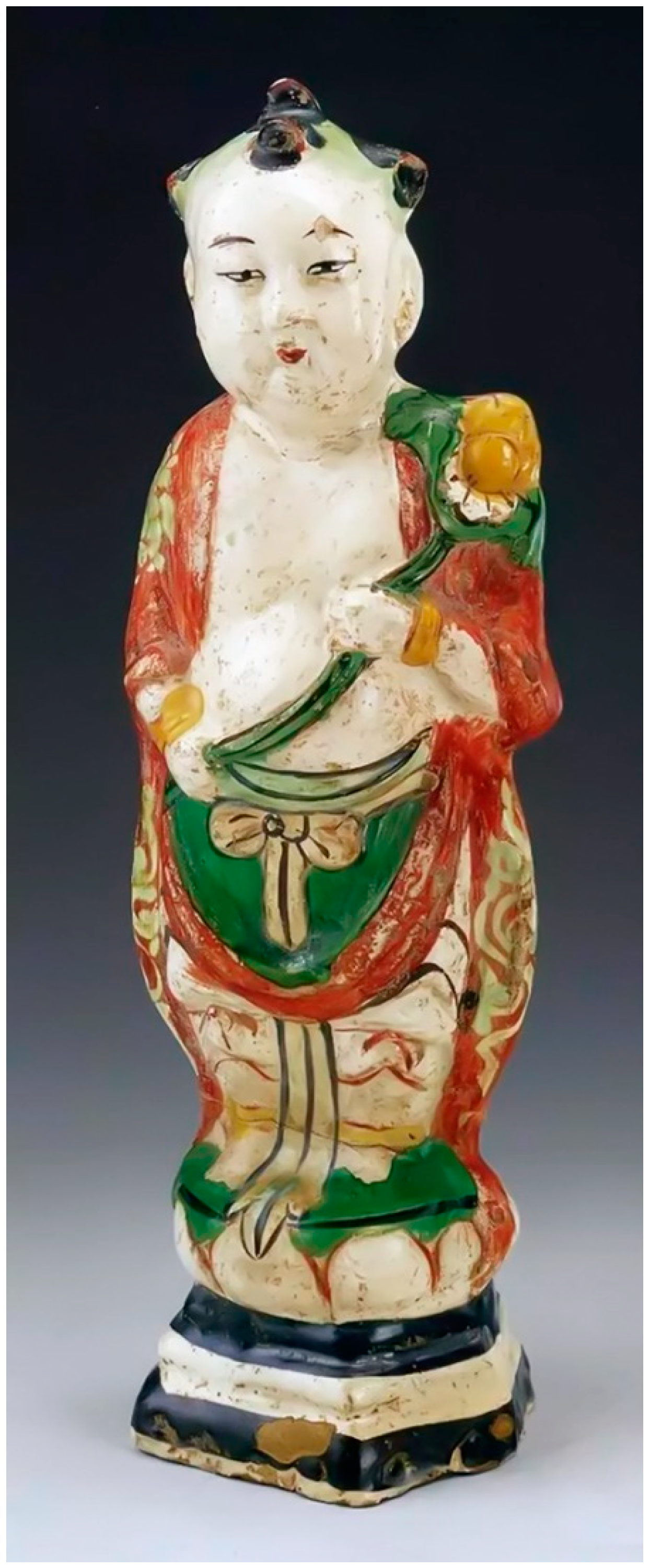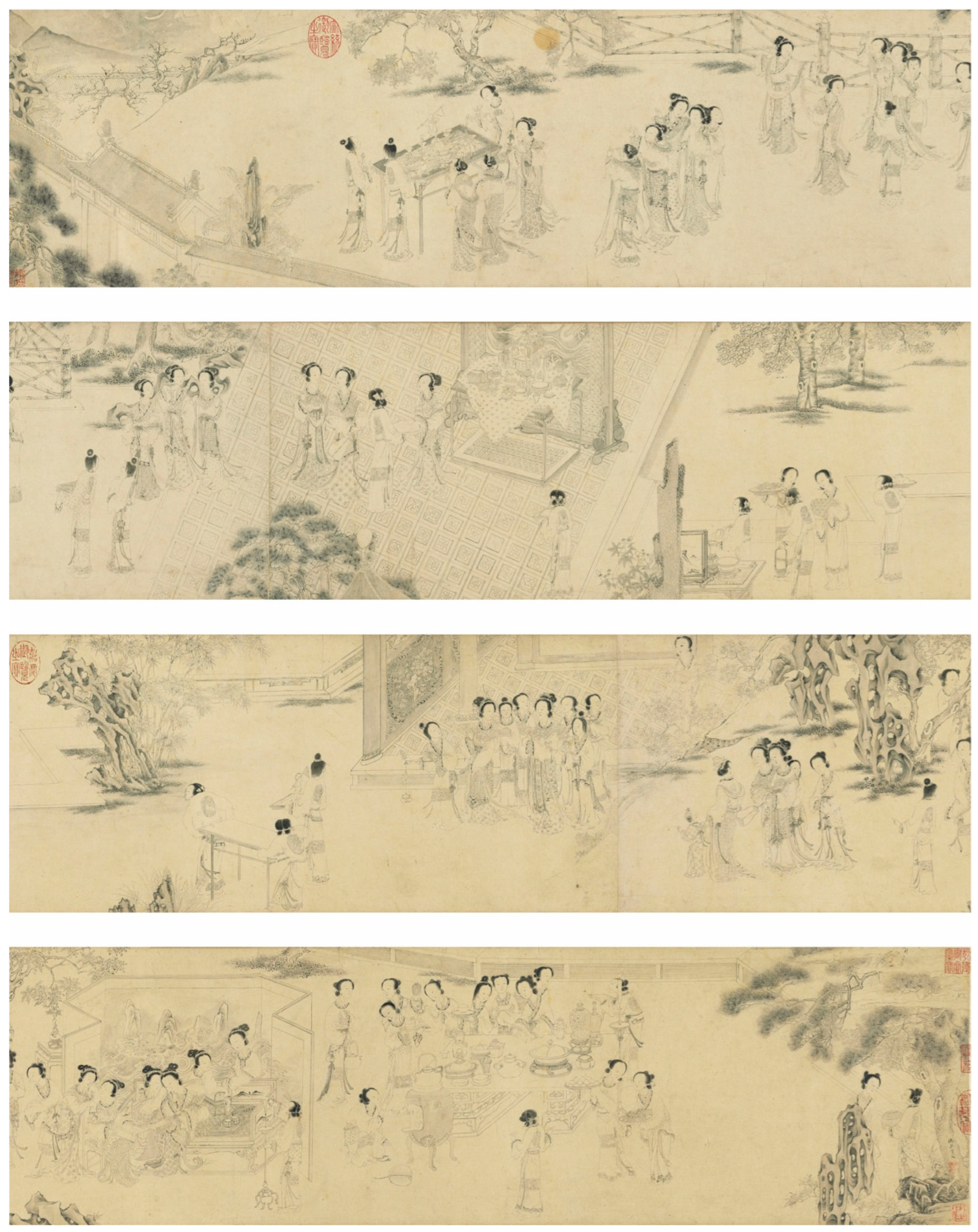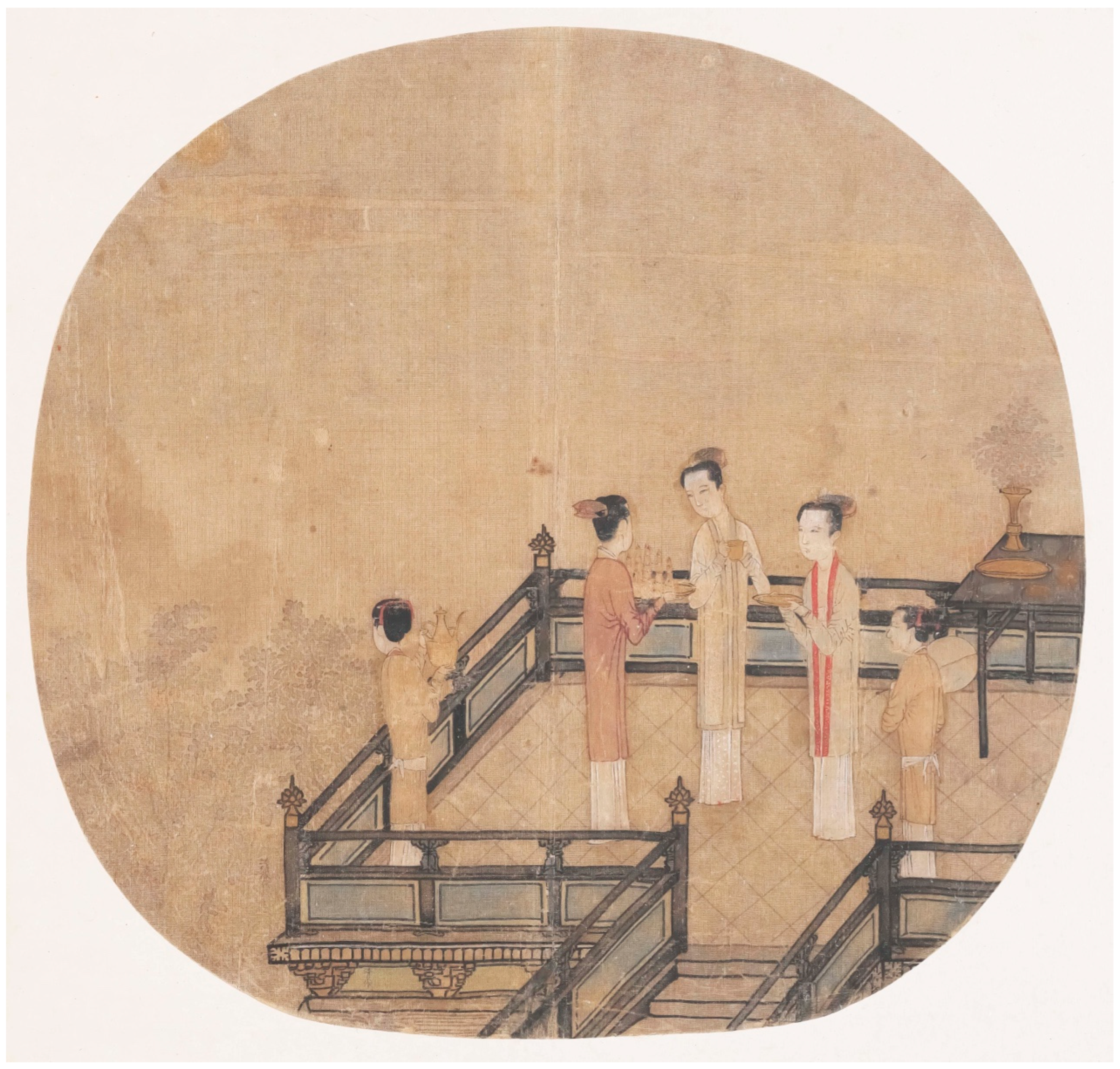1. Introduction
Mahoraga dolls, a kind of figurine showing a child holding a lotus leaf, were popularized nationwide throughout the Song Dynasty (960–1279), one of the most prosperous periods of Chinese history. Mahoraga has several Chinese names in different regions, such as “Mohele” 磨喝乐, “Mohouluo” 摩睺罗, and “Moheluo” 磨合罗, along with different Chinese characters, due to its different transliterations, which also reflects the scope of its popularity. Mahoraga dolls gradually faded from the historical stage and were barely seen in the Ming and Qing Dynasties (1368–1912). However, they are still of great significance in research because they are precious representative combinations of Indian Buddhism and Chinese folk culture. In Bianliang 汴梁, the capital in the Song Dynasty, every 7 July of the lunar calendar, citizens flocked to the crowded Panlou Street 潘家楼 (
Jin 1981, p. 34)
1 to purchase various festival articles, among which Mahoraga dolls were must-haves (
Figure 1). Due to a series of national policies ensuring the development of commerce, industry, agriculture, and culture, despite constant small clashes over boundaries, the people of the Song Dynasty generally lived rich lives in which religious ceremonies and folk activities, including Mahoraga worship at the Qixi Festival, flourished.
Recent academic research on Mahoraga dolls can be divided into three categories. The first explores the artistic value of these dolls from the visual art perspective. Zhao Wei studied the religious and folkloric meanings of child-holding-lotus-leaf dolls from the Song Dynasty from the iconographic perspective, focusing on the connection between the Mahoraga and the child (
Zhao 2015, pp. 20–25). This article was more concerned with the folkloric significance of the Mahoraga dolls than their religious allegorical connotations. Sun Facheng discussed the origin and evolution of the Mahoraga image by analyzing the child motifs on ceramic stools, arguing that the popularity of such motifs is directly related to the prevalence of the Mahoraga. Sun’s research reflected the impact of Mahoraga images on decoration art (
Sun 2014, pp. 135–43). Liu Jun based his argument on the transformation of the three artistic images of the Indian Brahminism “Mahākāla”, concluding that Mahoraga dolls in the Tang and Song Dynasties were a result of the confusion of “Mahākāla” and central China folk culture
2. In this process, Mahoraga gradually changed from a revered god to a child’s toy conveying the meaning of praying for reproduction and blessings (
J. Liu 2012, pp. 92–93).
The second category of research focuses on the folk culture of Mahoraga. Liu Zongdi did not agree with the view that Mahoraga originated from India, asserting that West Asia and ancient Babylon are the origin of the custom of worshipping Mahoraga in the Song Dynasty on Chinese Valentine’s Day (7 July in the lunar calendar). Based on historical textual research, he believed that Mahoraga originated from Tammuz or Adonis in West Asian myths and that its evolution was closely related to the fusion of Hinduism, Buddhism, and Zoroastrianism in the Central Asian Sutra region (
Z. Liu 2012, pp. 67–97). The latter provides new clues in the study of the association between Chinese festival customs and Western religious culture. Liu Jun examined the origin of Mahoraga, the spread of Buddhism, and the transformation of Mahoraga from gods to toys to underline the folkloric value of Mahoraga in Chinese Valentine’s Day worship in the Song Dynasty (
Liu 2010, pp. 105–9).
The third research category is the religious interpretation of Mahoraga. Yao Xiaoxuan researched Chinese Dunhuang 敦煌 documents, which recorded muhūrtu as the same thing as Mahoraga
3, as well as “huasheng” 化生,
4 a form of worship in Buddhist temples carried out during Ullambana Festival (15 July in the lunar calendar) (
Yao 2014, pp. 1–9). Yang Lin compared Mahoraga with “Huasheng” in an attempt to determine the relationship between and evolution of the two (
Yang 2009, pp. 21–33, 96). This study broadened the religious connotations of Mahoraga but lacked solid relic evidence. Yang Zhishui also discussed this relationship, suggesting that the image of Mahoraga is in accordance with Buddhist scripture, while “Huasheng” is freed from the constraints of scripture and has a more versatile image (
Yang 2002, pp. 57–59). Japanese gakuso Mujaku Dochu (1653–1745), artist Kokeshi Sakari (1890–1973), and scholar Kobayashi Taichiro (1901–1963) also participated in these origin debates and formed different hypotheses concerning Maharaga in Buddhist scripts from Mahiraga to Mahākāla (
Seizan 1994, pp. 79–100;
Kang 1998, pp. 44–55).
Overall, we believe that the existing research in this area has failed to take into account the dual value of religion and folklore in Mahoraga, let alone analyze it in its specific historical and social context. The word Mahoraga is not a native Chinese word: it comes from Indian Buddhism. However, Mahoraga dolls appear to be child-like native Chinese figures, with nearly no features of Indian Buddhist iconography nor any connections between their identity and image, yet they represent a harmonious union. This phenomenon aroused our research interest: How has a foreign religious culture been integrated with local folk culture so successfully? How can we process this transformation? What factors have contributed to this process? With these questions, we decided to research Mahoraga.
This paper discusses the Buddhist identity of the Mahoraga and the symbolic connotation of its shape. We next tackle the whole process of purchasing, preparing, and worshipping Mahoraga dolls to explore their inherent meanings. Finally, this study attempts to explain the popularity of Mahoraga dolls through analyzing the impact of the change in the social environment on the southward migration of the Mahoraga production industry, as well as the connection between their popularity and the crisis of the Song Dynasty. By analyzing the case of Mahoraga dolls, we hope to understand the cultural clashes, compromises, and the rise and fall of foreign religions in Chinese local culture. This will help us identify the specific means and characteristics of the spread of Indian Buddhism in East Asia.
2. Identification: Mahākāla, Mahiraga, Arhat?
Though there have been many different discussions concerning the identification of Mahoraga, one possibility is that this image came from Buddhism, a foreign religion that was introduced to China in the East Han Dynasty (25–220). Meng Yuanlao 孟元老 (year of birth and death unknown, lived in the Song Dynasty), in his
Records of Dongjing Dream 东京梦华录 (a description of the works of Bianliang, the capital of the Northern Song Dynasty), wrote: “Mahoraga in fact is the popular version of Muhūrtu in Buddhist scripture” (
Meng 2017, p. 152). Chen Yuanliang’s 陈元靓 (year of birth and death unknown, litterateur at the end of the Southern Song Dynasty), in
General Notes of the Years 岁时广记 (a book recording the festival customs of the Song Dynasty), said: “Mahoraga is the secular name of Muhūrtu in Buddhist scripture, and is also called ‘Qiao’er’ by the southerners (
Chen 1939, p. 34)”. These descriptions show that Mahoraga had different names in people’s daily lives. There are three interpretations of its signifier in the Buddhist scripture.
One possible origin is said to be Mahākāla, represented by Hu Shih’s (1891–1962) article “Moheluo” published in
Yishi Daily 益世报 (1935): “Moheluo is Magala, Mahagala, the transliteration of Mahakulu, in other name, Mahākāla” (
Hu 2008, pp. 526–30). Mahākāla is originated from Indian Brahminism, an incarnation of Maheśvara, and later was adopted in Buddhism as a protector deity. It has different patterns: one with two arms on one side, one with four arms on one side, and the other with six arms on one side. Usually, it has three eyes on its face, which shows an expression of fury, with a battle-ax in one hand and a blood-stained cranial weapon in another (
Li 2007, pp. 125–32). In the White Temple at the site of the Gurge Kingdom (800–892) in Zada County, Tibet, there is a four-armed image of Mahākāla (
Figure 2). Its body is covered in black. Cakravartin is sitting on a goddess,
5 with an expression of fury on his face and his red hair pointing straight upward. He wears a crown of five skulls. His left hand holds a trident and an alms bowl, while his right hand carries a sword and a cradle drum. The furious Mahākāla is made to intimidate demons and monsters and is very different from the cute child statue. However, there is no direct connection between its guardian duties and the function of Mahoraga in worship, for which further explanations are lacking in Hu’s article.
The second is said to be Mahiraga. For instance, Fu Yunzi thought that Mahoraga is a short term for Mahārgha, which is one of the Aṣṭasenā (
Fu 2000, pp. 104–11). In the Tang Dynasty,
Yi Qie Jing Yi Jing (a Buddhist dictionary) recorded “Mahārgha is the god of music, or said to be no-human, or maha-uraga. The latter has a human body and a snake head” (
Xu 2012, p. 697). In Cave 220 of Mo Kao Grotto 莫高窟 at Dunhuang 敦煌, Gansu 甘肃Province, a mural depicts Mahiraga (
Figure 3). With a snake crown on its head, Mahiraga has a stout body, wrinkled eyebrows, and a wide-open mouth, and his face is furious and terrifying. Yang Zhishui 扬之水 indicated that, after being introduced from India, Mahoraga evolved to have more Chinese features, and eventually changed from its snake-head human body to that of a cute child (
Yang 2012, p. 188). These two scholars above established a connection between Mahiraga and Mahoraga, but both failed to explain their inner similarities. Although the transformation of the images of gods is common in Buddhism, there are always similarities between the original and the variant in terms of shape or divinity. However, it is rather difficult to relate the snake-head image to that of a cute, well-behaved baby reasonably.
The last version is Arhat, which means that Mahoraga is Rāhula, the earthly son of Buddha. This view is the most convincing one. Rāhula is the royal son, and his gift and wisdom are auspicious, as recorded in Volume 55,
Abhiniṣkramaṇa Sutra 佛本行集经: “Rāhula was born six years after Tathāgata renounced. When Tathāgata returned, Rāhula turned six years old” (
Chen 2007, p. 665). Rāhula followed his father and was announced as a sramanera 沙弥when he turned 15 years old.
6 He strived to study scripts and was known as the first in the Secret Practice (
Chinese Religious Association 2017, p. 39;
Li 2007, p. 294). In Cave 133 in the Maiji Mount Grottoes 麦积山石窟 in Tianshui 天水, Gansu 甘肃 Province, there are two clay statues of Śākyamuni and Rāhula (
Figure 4). In these, Śākyamuni is bending his body and lowering his head, showing a kind facial expression, while Rāhula is also lowering his head, with joined palms and his feet on a lotus flower, as if he is expecting to receive tender care from his father. Rāhula is noble, diligent, and humble, almost in accordance with the perfect image of Mahoraga. Moreover, Rāhula was usually worshipped during the Ullambana Festival 中元节, while Mahoraga was enshrined in the Qixi Festival 七夕节. These two festivals are close in terms of dates; thus it is possible that people confused their festival articles. Additionally, the Chinese pronunciations of Rāhula (Luo Hou Luo 罗睺罗) and Mahoraga (Mo He Le 磨喝乐) are quite close; especially in some dialects, people had difficulties in distinguishing the sounds of “e”, “uo”, and “ou”. For those who are not able to comprehend Buddhism, it is easy to confuse the two names.
As we can see, all these assumptions were made within the scope of the cultural appropriation of Buddhism, while underestimating the significance of the secularization and popularization of Buddhist figures in the Song Dynasty. After being introduced to China in the Eastern Han Dynasty (25–220), Buddhism went through a long process of spreading, with continuous efforts to adapt it into folk culture, through integration with local religious beliefs, philosophies, moral values, and living conditions. In the Tang Dynasty (618–907), the spread of Buddhism reached its peak, while in Song, this trend featured a clear trace of secularization and popularization. For instance, Songzi Kuan-Yin送子观音 (sending children Avalokitesvara) was one of the most popular Buddha figures used in people’s lives, and this is not the original Avalokitesvara figure, which indicates that Avalokitesvara was endowed with a more earthly worshipping function. This phenomenon also provides evidence of the Song people’s practice of reproduction worshipping. Mahoraga is another example and has significance beyond figuring out its accurate Buddhism origin.
3. The Religious Allegory of Holding a Lotus Leaf Shape
The iconic symbol of Mahoraga is a child holding a lotus leaf in their hand. According to archaeological discoveries and the available written records, most of the Mahoraga dolls were boys and few were girls, and girl Mahoraga dolls were usually made to pair with boy ones. Additionally, we would like to focus on the Mahoraga figurines worshipped during Qixi Festivals, excluding other forms of child-holding-lotus figures, such as porcelain vases, jade pendants, and other jade accessories, on which girl images were often depicted. In fact, child patterns were not rare in ancient China and can be traced back to the Han Dynasty (202 BC–220 AD). These were not designed to reflect children’s lives but to convey the Chinese worship of procreation as well as the moral values relating to the family (
Huo 2017, pp. 25–30). Until Wei, Jin, Northern, and Southern Dynasties (220–420 AD), this longing became clearer with the preference for boys under the development of an agricultural civilization. In the Tang Dynasty (618–907), child-holding-lotus patterns relating to this religious allegory were frequently used on Songzi Kuanyin statues (
Rong 2013, pp. 245–76), which can be further proven as this typical Mahoraga figure was not only seen on figurines used in worship but also on ceramic stools used around Qixi Festivals (
Figure 5).
This white-glazed stool from Hebei, China, is 21 cm long, 17.1 cm wide, and 15.8 cm high. It depicts a scene of a baby wrapping his hands around a lotus leaf. This work can be divided into three parts: the base, the child, and the lotus leaf. The base is rectangular. The child lies on his side on the base, face up, his legs curled up, and his hands around the lotus leaves. The lotus leaves droop back and forth, warp left and right, and are concave in the middle, forming a curved surface suitable for a stool.
For example, the white-glazed red and green porcelain Mahoraga (
Figure 6) from the Song Dynasty in the Wangye Museum in Shenzhen, China, is 17.5 cm high and depicts a boy with stylized hair sitting on a drum pier. The boy is wearing a red vest and a green skirt, holds a lotus leaf in front of his chest, and has black boots on his feet. The red and green porcelain Mahoraga (
Figure 7) from the Song and Jin Dynasties in the Tianjin Museum is 30.8 cm high. This Mahoraga’s hair is tied in a bun, and he wears a red–green knee-length coat with buttons down the front and a ribbon on his waist. Additionally, his hands are holding a lotus leaf and he is standing on a lotus base. Both these two Mahoraga statues show peaceful, devout faces and hold the lotus in a pious manner without childish facial expressions or naughty gestures. Their physical childish features were minimized while their overall appearance was manufactured to have similar characteristics to those of the Buddhas consecrated in temples. Bold colors of red and green were frequently used for Mahoraga dolls to echo the pursuit of happiness and blessings in folk culture. From this, we can conclude that Mahoraga represents a combination of Buddhism and Chinese folk art, while at the same time conveying the connotations of reproduction.
Zhou Mi 周密 (1232–1298, The Southern Song Dynasty) in
Wulin Old Story 武林旧事 stated: “in Qixi Festival, many children imitate muhūrtu to dress with lotus patterns, and hold lotus leaves. I suppose this is old customs” (
Zhou 2011, p. 56). Wu Zimu 吴自牧 (People of the Song Dynasty), in his
Meng Liang Record 梦梁录, claimed: “On 7 July (the lunar calendar), streetwise kids dress like Muhūrtu, holding fresh lotus leaves in their hands” (
Wu 1985, p. 24). These two records both specify children’s imitation of Mahoraga, illustrating the importance of lotus leaves in the Mahoraga shape based on their symbolic meaning.
Lotus plants grow in water, and water is the earliest symbol of the constitution of the universe and the primordial ocean; thus, in Egypt and India, the lotus is seen as a sacred object that nurtures all life and symbolizes the womb of the universe (
Zhang 2005, p. 57). In fact, this feature of reproduction is exactly the reason why the lotus is highlighted in Buddhism: the lotus flowers are considered to be a manifestation of the past, present, and future because they represent the succession and continuation of life through blooming, fading, and bearing fruit. The Buddhist lotus culture was gradually secularized after it was introduced into China, and during the Song Dynasty, it was fused with folk culture. People used metaphors, harmonies, and allusions to express the symbolism of the lotus, among which the most common combination is lotus and children together, signifying “having children one after another 连(莲)生贵子” (the word “lotus” has the same pronunciation as the Chinese word for “continuous”). This fertility symbolism of the lotus coincides with the use of Mahoraga dolls, as Mahoraga was often worshipped when praying for offspring, which also explains why Mahoraga figurines are usually depicted with a lotus in their hands.
The earliest record of a child holding a lotus is from a story recorded in On Moral Character, Ulambana Sutra of Mahavaipulya Buddha 报恩经·论议品. In this story, Polonai King married Lady Deer Mother and brought her into the palace; the lady became pregnant but gave birth to a lotus flower. She was condemned, and the lotus flower was then abandoned in a pond in the back garden. One day when the king was having a feast beside the pond, the pond trembled, and the lotus in the pond was seen to be the same as the one born by Lady Deer Mother. At that time, the lotus flower emitted a wonderful red light, which amused the king, who immediately sent a servant to fetch the flower. This lotus flower had 500 leaves, each with a healthy-looking boy standing on it, indicating the link between lotus flowers in Buddhist culture and more sons. This story is the origin of the depiction of Mahoraga dolls holding a lotus shape, demonstrating their religious significance, and this results in people praying to Mahoraga to ask for children in the Song Dynasty during the Qixi Festival.
4. Mahoraga in the Praying to the Vega Ceremony
Qixi Festival is the most important situation in which Mahoraga is worshipped, as this festival resulted from the ancient Chinese tradition of worshipping stars. In the Han Dynasty 汉代 (202 BC–220 AD), a mythical love story of a cowherd and the goddess of weaving (the goddess of Vega) was added, while in the following Wei and Jin Dynasties 魏晋 (220–420), the ceremony of praying to the Vega began. Young girls then prayed to the star in order to obtain the gift of weaving, needling, etc., and this ceremony was given more attention than ever in the Song Dynasty. To celebrate the festival, people went shopping for festival items, from 1 July (the lunar calendar), as recorded in
Drunken Man’s Sayings 醉翁谈记 by Jin Yingzhi 金盈之: “Many praying items were selling in front of Panlou 潘楼 and the street became overcrowded with horses and carriages. The traffic turned extremely terrible till 4 July, three days ahead of the Qixi Festival, and throngs were stuck on the street when night fell” (
Jin 1981, p. 34). This description depicts how people enthusiastically participated in celebrating the festival. Various commodities were sold on the streets, and among them, Mahoraga figurines were the most important objects needed for the ceremony; this is demonstrated in the Song script “
Grinding a Jade Statue of Avalokiteśvara” 碾玉观音, which confirms Mahoraga dolls as a necessity in praying during the Vega Ceremony, while in people’s daily lives they have no specific use (
He 1983, pp. 1–22). Additionally, the Song royal court took the festival seriously, as recorded in the royal sacrificial rites book. In
Song History 宋史, it is mentioned that “just like the importance of lanterns to the Lantern Festival, Swings to the Gold Food Festival, Muhūrtu is a must to Qixi” (
Chen 2003, p. 1670).
According to
Records of Dongjing Dream, on 4–5 July the festive atmosphere became more intense, and every family bought their children fresh lotus leaves in order to imitate Mahoraga (
Jin 1981, p. 160). On 6–7 July, people started to build prayer buildings to display sacrifice items, and these buildings varied in terms of shape and material due to the different social classes of the people who made them. The royal court built silk tents a hundred feet high that could accommodate dozens of people; members of the gentry and other civilians used bamboo, wood, or hemp straw to weave prayer houses. However, no matter what material was used, the Mahoraga figurine was the core article that could not be missed in the ceremonies performed by any class (
Zhou 2011;
Wang 2012;
Jin 1981).
On the night of 7 July, the prayer ceremony began; all the participants were female, and men were not allowed to be involved. This is because, in the widespread Cheng-zhu Confucianism and other dominant moral virtues, women were thought to be the primary bearers of reproduction responsibilities, while, at the same time, they were required to obey strict rules of gender segregation by minimizing unnecessary contact with male family members. The most important two ceremonies were “threading needle towards the moon” 望月穿针 and “using spider silk to practice divination” 蛛丝卜巧. The former ceremony was described as very difficult in
General Notes of the Years 岁时广记, as girls needed to be able to thread a specific needle with seven holes; the latter required young ladies to put spiders into golden and silver boxes, and they would be judged as “ingenious” 得巧 if their spider web was the most accomplished. The picture “Praying for the Ingenuity” 乞巧图 in Taipei Palace Museum painted by Chouying 仇英 (
Figure 8) shows the ceremony at night in the palace. In this image, 76 ladies are depicted: some of them are preparing food and drink, some are threading needles toward the moon, some are using spider silk to practice divination, and some are praying. A brown doll is placed in the center of the altar; this is the Mahoraga (
Figure 9), which appears to be a full-bodied, lively figure with a sideways-slanting head and a lotus on his shoulders. From this picture, we can determine the importance of this ceremony for women and their worship of Mahoraga.
The connotations of performing this praying ceremony changed from begging for weaving skills to begging for children. At that time, the Moon was regarded to have the magical power of fertility, which is also mentioned in Chen Shidao’s 陈师道 (1053–1102)
Various Talks behind Hills 后山丛谈. He suggested that, during the mid-autumn festival, once the moon cast her light, rabbits became pregnant after seeing the moon, clams started their reproduction cycles, and buckwheat could have firmer grains (
Chen 1989, p. 52). Therefore, threading toward moonlight symbolized the sexual intercourse between man and woman, which stressed the importance of reproduction. Additionally, the other ceremony “using spider silk to practice divination” also conveys the same meaning of reproduction. Spiders are also called “Xi Zi” 喜子 in Chinese, which can be translated into “blessed child” or “fortune”; thus, in China, many people take spiders as a sign of good fortune. Spiders have a strong reproductive capacity and produce multiple egg sacks with dozens of eggs (
Zhao 1985, pp. 8–11). Spider webs are often intertwined, which is interpreted to be an indication of romantic love. In addition, fruits and melons are also used in this ceremony because of their similar symbolic meanings in Chinese culture. Early in
The Book of Songs 诗经·大雅, Confucius wrote the phrase “continuous descendants like continuous melon vines” 绵绵瓜瓞, which indicates the symbolic connection between fruits and melons and reproduction (
Kong 2001, p. 220). In Liu Zongu’s 刘宗古 “A Picture of Walking under the Moon on Yao Tai 瑶台步月图” (Yao Tai is said to be the dwelling place of gods) (
Figure 10), a female servant is holding a plate of Mahoraga, while the other two women are looking at the plate. Mahoraga in this period has become an embodiment of perfect children in women’s minds.
Through the analysis above, we can find that in the Song Dynasty, Qixi Festival was not only celebrated for women’s pursuit of ingenuity but also was a place where people could pray for children. Though it was women’s social and familial duty at that time to give birth to children, this requirement of women was not announced publicly due to Confucianism. Therefore, this demand was expressed in a more private way by women performing Qixi ceremonies without the participation of male family members. After this, young ladies performed threading, fortune telling, and other worship rituals, revealing their desire for fertility.
The popularity of Mahoraga is closely connected with the prevailing trend of praying for children at the Qixi Festival, which is rooted in a historical background. As mentioned above, throughout the Song Dynasty, many regional conflicts and battles took place. The Song court took part in continuous wars with the surrounding Liao Dynasty 辽代 (907–1125), the Western Xia 西夏 regime (1038–1227), the Jin Dynasty 金代 (1115–1234), and later the Yuan Dynasty 元代 (1271–1368), which exhausted the pool of young laborers nationwide. In order to replenish the military, the government implemented a recruitment system, conscripting a large number of young laborers to the battlefield and thus taking them away from agricultural production, resulting in farmland desolation. In return, the military system further aggravated the financial burden on workers by increasing the tax pressure, making them less willing to have children. Moreover, the poor standards of medical care also restricted the growth of the population. Even in the royal family, which had access to the best medical care, over 45% of the 181 royal children born throughout the Song Dynasty died at young ages, excluding two who died in war (
Wang 1984, p. 51).
To solve this problem, the Song government formulated a series of policies to promote population growth, such as property inheritance, acts supporting the raising of children, tax guarantees, etc. For instance, the laws of the Song Dynasty stated that those who have no sons, should give all of their property to the country, except for those leaving their land to daughters; this was one of the reasons why the Song people valued heirs (
Cang 1995, p. 75). In order to solve the problem of abandonment, the government enacted the law regarding child adoption, allowing people without children to adopt orphans. The government set up the “CiYou Bureau 慈幼局” or “Baby Bureau 婴儿局” in different regions to adopt abandoned children.
8 Poor families who had difficulties in raising children would be sponsored by a specific organization called “Juzi Cang 举子仓”. In 1138,
9 the government stipulated that “the poor families below the fifth grade in the countryside and the seventh grade in the township, that could not feed their children, regardless of genders, were to be exempted from paying 4000
qian tax per person” (
Li 2013, p. 2221). These acts above demonstrate the governmental emphasis on increasing the population.
This strong desire for fertility had a great impact on the Song people’s festival conventions. The conversion of the function of Mahoraga from a Buddhist image to a reproductive symbol suggested that the psychological value of the Mahoraga had surpassed its religious connotations, with it later evolving to represent the spiritual trust of the Song people in reproduction as well as the endurance of the Song Dynasty. After all, since the very beginning, the worshipping activities in Qixi Festival had emphasized women’s virtues, regardless of the pursuit of ingenuity or the responsibility of having children. This change of worshipping purpose in the Song Dynasty echoed with the localization of Buddhism from the end of the Tang Dynasty, especially the worshipping of a lotus-holding child in Songzi Kuanyin statues as mentioned above, Qixi Festivals then promoted the popularity of Mahoraga worshipping in festival ceremonies, indicating the process of a Buddhism element becoming an important part of Chinese folk customs.
5. Mahoraga and the Population Crisis
The prevalence of Mahoraga in folk culture resulted from the Song people’s desire to have children, especially boys; yet, this situation was triggered by both external encouragement and internal anxiety around reproduction. According to a population study, the Song Dynasty was a milestone in the history of the development of the Chinese population in ancient times, with the country reaching a population of more than 100 million by the end of the Northern Song Dynasty (
Qi 2019, p. 46;
Li 2013, Appendix V;
Wang 1995, p. 297).
The Song regime and its people faced a severe population crisis: on the one hand, the Song Dynasty engaged in decades of chaotic wars in the Five Dynasties and Ten Kingdoms (907–979), with countless male laborers losing their lives and leaving huge amounts of land barren. Male laborers were therefore in high demand to solve the agricultural recession. On the other hand, though the Song regime reunified China, it was constantly threatened by the north nomadic nation, and thus the government needed to recruit more soldiers and send them to the borders.
Therefore, the new regime attempted to stabilize the situation nationwide and brought out multiple policies to encourage procreation. Emperor Zhao Kuangyin 赵匡胤 (939–997) initiated several strict policies in 961, the second year of the regime, to stimulate the recovery of agriculture and ensure the population was maintained. These policies influenced his successors for a long time, with them introducing similar measures (
Xia 2003, p. 39). The regime chose to compromise with the northern nomads and even decided to migrate south of the Changjiang River in 1127 to avoid further conflicts and wars. Though being accused of cowardliness, the Song emperors managed to maintain a prosperous and peaceful society within their shrinking territories. In addition, the Song Dynasty was a time when Cheng-Zhu Confucianism became an official philosophy based on a series of moral virtues, of which familial ethics were one important component. Under these complicated circumstances, the Song people formed a strong desire to give birth to babies—male babies, in particular.
In terms of the geographical distribution of population growth, the southern part of China showed an annual increasing trend in the number of households. In the early years of the Song Dynasty, the total number of southern households accounted for 60.8% of the total number nationwide. From 1078 to 1085, this proportion rose to 65.97%, while from 1102 to 1106, the number was at 67.24%. Jiangnan District, Jiangxi Province, and Sichuan Province, south China, each had populations of over 10 million. Jiangnan District had the largest population, and in 1223, the number of households reached 3.58 million (
Wang 1995, pp. 18–19). Lin’an and Pingjiang were the two cities that had the highest population growth. According to the
Xianchun Lin’an Gazaetters 咸淳临安志, in 1169, there were 261,692 households, and in 1265–1274, there were 391,259 households; meanwhile, in Pingjiang District, as recorded in
Zhengde Gusu Annals 正德姑苏志, there were more than 173,000 households in 1184 and more than 329,600 in 1275 (
Cheng 2002, p. 118).
According to the national statistics, in 997, there were 4,132,576 households, while in 1021, this number doubled. In 1063, this number reached 12,462,317, and in 1110, the recorded number was 20,882,258, with 46,734,784 male residents, as the female population was not counted in any individual statistics. This also reflects the fact that women possessed a lower social position and helps us to understand why girl Mahoraga are seldom seen in written texts or archaeological discoveries.
Population growth in the south occurred in two different ways. The first way was due to population migration, as constant border conflicts took place in the north part of China and people decided to move southward to avoid being affected by the regional battles and the resulting land disputes. The other reason for population growth was the prosperous economy in the southern area, which led to the improvement of living conditions. Professor Ge Jianxiong 葛剑雄 argued that, throughout the history of China, the most densely populated regions were normally the most economically and culturally developed areas, where people had the highest levels of living conditions. If there were no such well-developed commerce, handicrafts, and services in Suchow city, no imported immigrants, and the entire population of residents lived on farming, there would not have been such a large population, not to mention one so prosperous (
Ge 2005, p. 639). Meanwhile, the broadening of economic channels guaranteed the increase in population. In
Meng Liang Record 梦梁录, Wu Zimu 吴自牧 wrote of the prosperous street scene in Lin’an, the capital city of the Southern Song Dynasty: “Different sizes of stores and shops were crowdedly opened all over each street and alley, so there were no empty room. Every early morning, hundreds of shops open on the main two streets, and people went out doing all kinds of trades until the dinner time. This makes Hangzhou (Lin’an) a very central commercial city different from the surroundings places, with thousands of customers and vendors coming and leaving…” (
Wu 1985, p. 11).
The stable society and prosperous economy in the south ensured the Song people decent living conditions, enabling them to have more children. Thus, in the Qixi Festival ceremony, they were likely to use sacrifices with symbolic connotations, and they were able to afford the expense. This then fostered the demand for Mahoraga figurines, and the more densely populated and better developed the area was, the more market demand there would be for Mahoraga. Therefore, artisans migrated southward directly to prosperous cities in order to save costs in manufacturing and transportation. One street called “Child Lane 孩儿巷”, which featured Mahoraga production in the Song Dynasty, has survived until now in Hangzhou. Though its function has changed and Mahoraga are no longer sold on the street, this still provides evidence of the popularity of Mahoraga in the history of China.
6. Conclusions
To conclude about the prevalence of Mahoraga figurines in the Song Dynasty, we believe that they can be regarded as an example of cultural appropriation that exemplifies the adaption of foreign religion in ancient China. Mahoraga dolls have a complicated historical background, with reproduction being a priority nationwide in all sections of society, a prosperous economy providing the necessary conditions for the mass consumption of handicrafts, and these figurines originating from the merging of Buddhism with folk culture. Worshipping Mahoraga, a figurine of a child holding a lotus, under these circumstances had multi-layered political, national, cultural, and religious connotations as a consequence.
However, the enthusiasm for these figurines quickly faded when the Song regime collapsed. Its successor, Yuan (1271–1368), established by the Borjigins 孛儿只斤, was the first minority ethnic regime, yet also the shortest regime, in the history of China and realized the Grand Unification. The 98 years under the rule of this Mongolian regime brought disturbances to the passing down and continuation of Han culture, both literarily and ideologically, as Han people, the majority ethnic group of China, were politically identified as the lowest class in the hierarchy of ethnic classifications. We assume that this strict hierarchy system caused constant national conflicts, harming the passing down of folk culture and the lives of citizens, including the practice of Mahoraga worship in Qixi Festivals. As a result, Mahoraga figurines were mentioned less and less over time in the textual records and cannot be seen in archaeological evidence from the following dynasties.
